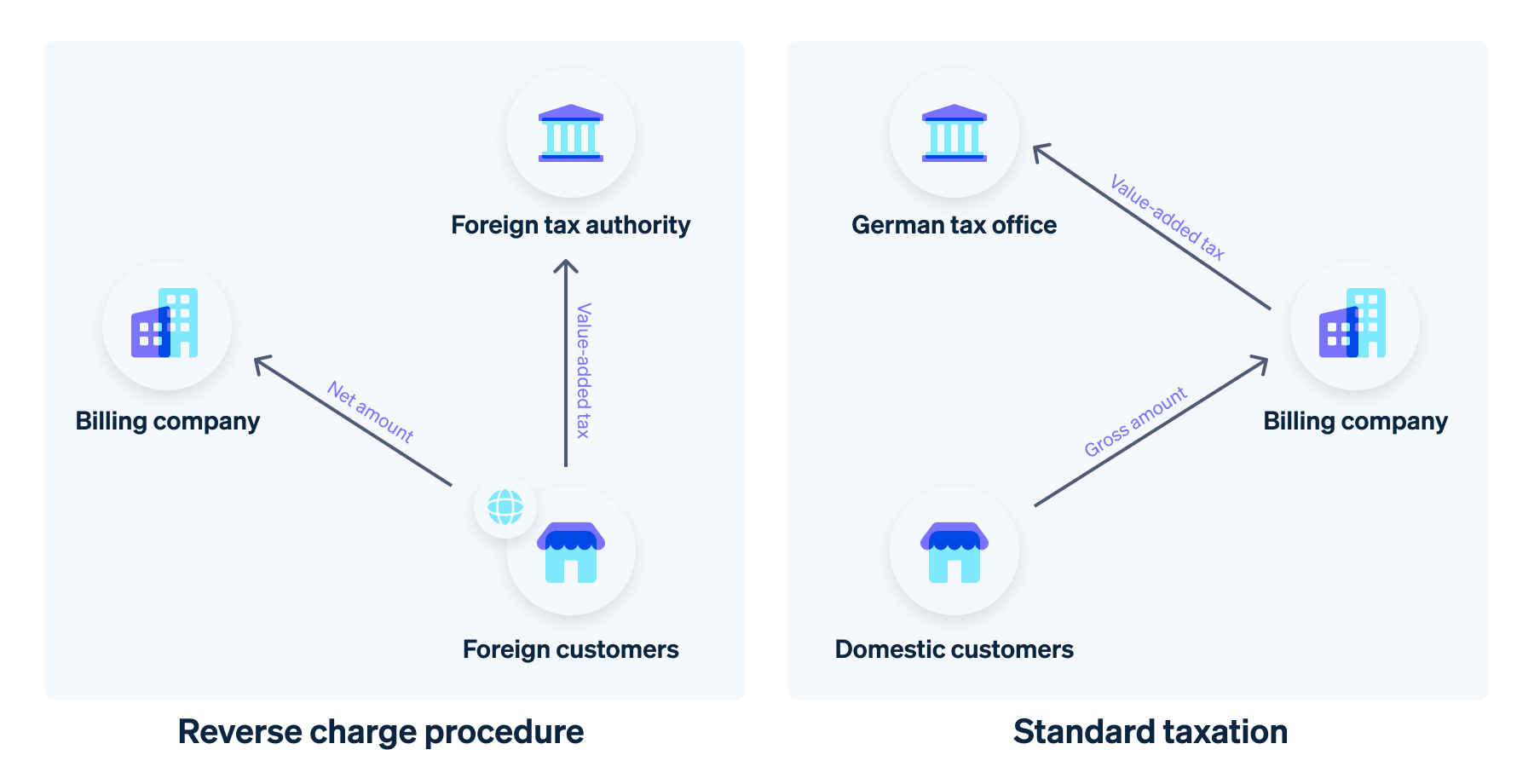ขั้นตอนการเรียกเก็บเงินปรับคืนจะใช้เมื่อจัดส่งสินค้าและบริการในต่างประเทศ ธุรกิจที่มีการดําเนินงานในต่างประเทศจะต้องศึกษากระบวนการนี้อย่างละเอียด เนื่องจากส่งผลกระทบต่อภาระหน้าที่ด้านภาษีมูลค่าเพิ่ม (VAT) และการออกใบแจ้งหนี้เป็นอย่างมาก
อย่างไรก็ตาม จะมีการปรับคืนการเรียกเก็บเงินในบางกรณีภายในประเทศด้วย ในบทความนี้ คุณจะได้ศึกษาว่าการเรียกเก็บปรับคืนคืออะไร ประเทศและบริการใดบ้างที่ใช้กระบวนการนี้ รวมถึงเหตุผลที่นำมาใช้ นอกจากนี้ เราจะอธิบายวิธีสร้างใบแจ้งหนี้การเรียกเก็บเงินปรับคืนที่ถูกต้องด้วย
บทความนี้ให้ข้อมูลอะไรบ้าง
- ขั้นตอนการเรียกเก็บเงินปรับคืนคืออะไร
- ต้องใช้ขั้นตอนการเรียกเก็บเงินปรับคืนเมื่อใด
- เหตุใดจึงมีขั้นตอนการเรียกเก็บเงินปรับคืนขึ้นมา
- ขั้นตอนการเรียกเก็บเงินปรับคืนใช้กับประเทศใดบ้าง
- วิธีการออกใบแจ้งหนี้ที่มีขั้นตอนการเรียกเก็บเงินปรับคืนอย่างถูกต้อง
ขั้นตอนการเรียกเก็บเงินปรับคืนคืออะไร
ขั้นตอนการเรียกเก็บเงินปรับคืนคือระเบียบข้อบังคับที่ยึดตามกฎหมายภาษีมูลค่าเพิ่มของเยอรมนีและยุโรปตามมาตรา 196 ของกฎหมายภาษีมูลค่าเพิ่มของเยอรมนี (UStG) สําหรับการจัดหาสินค้าและบริการข้ามพรมแดนส่วนใหญ่ระหว่างบริษัทที่ต้องเสียภาษี ภาระหน้าที่ด้านภาษีจะโยกไปอยู่ที่ผู้รับ บริษัทที่โดยปกติแล้วจะออกใบแจ้งหนี้ค่าบริการจะชําระภาษีมูลค่าเพิ่มให้กับสํานักงานภาษี อย่างไรก็ตาม ภายใต้ระบบการเรียกเก็บเงินปรับคืน จะมีกรณีพิเศษซึ่งภาษีมูลค่าเพิ่มจะไม่ได้ชำระโดยบริษัทที่ให้บริการ แต่เป็นบริษัทที่รับบริการ ซึ่งหมายความว่าผู้ให้บริการสามารถแสดงเฉพาะยอดเงินสุทธิในใบแจ้งหนี้เท่านั้น หลักเกณฑ์ทางกฎหมายสําหรับขั้นตอนการเรียกเก็บเงินปรับคืนคือมาตรา 13b ของ UStG
ขั้นตอนนี้ยังใช้ภายในประเทศในบางกรณีด้วย เช่น บริการก่อสร้างและบริการทําความสะอาด เนื่องจากภาคธุรกิจเหล่านี้มีความเสี่ยงต่อการฉ้อโกงภาษีมูลค่าเพิ่มเป็นพิเศษ เพื่อหลีกเลี่ยงการจ่ายภาษีมูลค่าเพิ่มโดยบริษัทผู้รับบริการ (แต่ไม่ใช่บริษัทที่ให้บริการ) บางครั้งภาระหน้าที่ทางภาษีจึงโอนไปให้ผู้รับบริการ ซึ่งปกติแล้วจะเป็นลูกค้าในประเทศที่มีสิทธิ์ในการหักภาษี
ขั้นตอนการเรียกเก็บเงินปรับคืนเทียบกับการเก็บภาษีมาตรฐาน

ต้องใช้ขั้นตอนการเรียกเก็บเงินปรับคืนเมื่อใด
โดยทั่วไปแล้ว การเรียกเก็บเงินปรับคืนจะสามารถทําได้ในภาคธุรกิจ B2B เท่านั้น เช่น เมื่อบริษัทให้บริการแก่บริษัทอื่น บุคคลทั่วไปไม่รวมอยู่ในขั้นตอนการเรียกเก็บเงินปรับคืน อีกข้อกําหนดที่สําคัญคือบริการนั้นๆ จะต้องเสียภาษีในเยอรมนี หากเป็นไปตามเงื่อนไขเหล่านี้ ข้อกําหนดข้อ 13b(1) และ (2) ของ UStG จะมีผลบังคับใช้
การปรับคืนความรับผิดทางภาษีสามารถทําได้สําหรับบริการต่อไปนี้
- งานหรือบริการอื่นๆ ที่ดําเนินการโดยบริษัทที่จัดตั้งขึ้นในต่างประเทศ (งานหมายถึงการจัดหาสินค้าสําหรับการดำเนินการหรือการจัดการ โดยที่บริษัทผู้จัดหาใช้วัสดุที่ตนหามาด้วยตัวเอง)
- การจัดส่งวัตถุที่กำหนดให้เป็นหลักทรัพย์นอกเหนือจากกระบวนพิจารณาคดีล้มละลาย นั่นคือ กรรมสิทธิ์ในวัตถุที่เคลื่อนย้ายได้ถูกโอนจากลูกค้าไปให้เจ้าหนี้โดยไม่มีการเปลี่ยนแปลงในกรรมสิทธิ์
- ยอดขายที่อยู่ภายใต้กฎหมายว่าด้วยภาษีการโอนอสังหาริมทรัพย์ (RET) อย่างสมบูรณ์
- การซื้อบริการด้านการก่อสร้าง เช่น งานที่เกี่ยวข้องกับการก่อสร้าง การซ่อมแซม การดัดแปลง หรือการกำจัดสิ่งก่อสร้าง เมื่อผู้รับเป็นผู้ให้บริการก่อสร้างด้วยตัวเองอย่างต่อเนื่อง
- การจัดหาแก๊สผ่านเครือข่ายก๊าซธรรมชาติและไฟฟ้า
- การจัดหาทองและการชุบทอง
- การจัดหาอุปกรณ์มือถือ คอมพิวเตอร์แท็บเล็ต คอนโซลเกม และวงจรรวมที่มีมูลค่าอย่างน้อย €5,000 และบริการโทรคมนาคมอื่นๆ
- บริการทําความสะอาดอาคารและชิ้นส่วน เมื่อผู้รับบริการเป็นผู้ให้บริการทําความสะอาดอาคารเอง
ขั้นตอนการเรียกเก็บเงินปรับคืนใช้กับธุรกิจขนาดเล็กด้วยหรือไม่
ขั้นตอนการเรียกเก็บเงินปรับคืนไม่ใช้กับบริษัทที่ใช้ข้อบังคับของธุรกิจขนาดเล็กตามมาตรา 19 ของ UStG จะเป็นการดีกว่าสําหรับธุรกิจเหล่านี้ที่จะซื้อบริการของตนภายในประเทศ เนื่องจากจะต้องจ่ายภาษีมูลค่าเพิ่มด้วยตัวเอง ธุรกิจขนาดเล็กมีหน้าที่ต้องชําระภาษีมูลค่าเพิ่มสําหรับประเทศที่สามให้กับสํานักงานภาษีในเยอรมนีโดยใช้ขั้นตอนการเรียกเก็บเงินแบบปรับคืน ถึงกระนั้น ธุรกิจเหล่านี้ก็ไม่สามารถเคลมจํานวนเงินดังกล่าวเป็นภาษีซื้อได้
เหตุใดจึงมีขั้นตอนการเรียกเก็บเงินปรับคืนขึ้นมา
มีการใช้ขั้นตอนการเรียกเก็บเงินปรับคืนด้วยเหตุผลหลายประการ ทั้งเพื่อการป้องกันและการใช้งานจริง:
- หลีกเลี่ยงการฉ้อโกงภาษีมูลค่าเพิ่ม: หนึ่งในสาเหตุหลักในการใช้กลไกการเรียกเก็บเงินปรับคืนก็คือสิ่งที่เรียกว่า Carousel Fraud. ธุรกิจอาจฉวยประโยชน์จากช่องโหว่ในกฎหมายภาษีมูลค่าเพิ่มแบบข้ามพรมแดน นั่นคือเมื่อมีการซื้อขายสินค้าหรือบริการระหว่างประเทศ ผู้ซื้อจะเคลมภาษีซื้อ แต่ผู้ค้าไม่ได้จ่ายภาษีมูลค่าเพิ่ม กลไกการเรียกเก็บเงินปรับคืนจะป้องกันไม่ให้บริษัทในประเทศผู้รับได้รับเงินคืนภาษีมูลค่าเพิ่มโดยที่ไม่ต้องจ่ายก่อน
- ทําให้ธุรกิจข้ามพรมแดนเป็นเรื่องง่าย: สําหรับธุรกิจในสหภาพยุโรปที่ให้บริการหรือสินค้าข้ามพรมแดน กลไกการเรียกเก็บเงินปรับคืนจะช่วยให้จัดการภาระหน้าที่ด้านภาษีมูลค่าเพิ่มได้ง่ายขึ้น ธุรกิจที่ดําเนินงานในประเทศสมาชิกสหภาพยุโรปไม่ต้องกังวลเกี่ยวกับการจดทะเบียนและการชําระภาษีมูลค่าเพิ่มในทุกประเทศที่ให้บริการ ซึ่งช่วยลดภาระด้านการบริหารและลดความยุ่งยากในการทําบัญชีสําหรับธุรกิจที่ดําเนินงานในต่างประเทศ
- กระบวนการที่มีประสิทธิภาพมากขึ้น: ห่วงโซ่คุณค่ามักจะประกอบด้วยผู้เล่นหลายฝ่ายในหลายอุตสาหกรรม รวมถึงการก่อสร้าง การเรียกเก็บเงินปรับคืนช่วยลดความจําเป็นที่ซัพพลายเออร์แต่ละรายจะต้องชําระภาษีมูลค่าเพิ่มและรับเงินคืนในภายหลัง โดยผู้รับในขั้นสุดท้ายจะมีหน้าที่รับผิดชอบแทน ทําให้กระบวนการมีประสิทธิภาพมากขึ้น และลดโอกาสที่จะเกิดความผิดพลาดในการเก็บภาษี
- ทําให้สํานักงานภาษีทำงานง่ายขึ้น: ขั้นตอนการเรียกเก็บเงินแบบปรับคืนยังทําให้การทํางานของหน่วยงานภาษีในเยอรมนีง่ายขึ้น เนื่องจากหน่วยงานเหล่านี้ไม่ต้องบังคับใช้การเคลมภาษีในต่างประเทศ และยังง่ายสำหรับสำนักงานภาษีในประเทศอื่นๆ ด้วย ด้วยวิธีนี้ กระบวนการเรียกเก็บเงินปรับคืนจะจึงช่วยแบ่งเบาภาระของหน่วยงานด้านภาษี
ขั้นตอนการเรียกเก็บเงินปรับคืนใช้กับประเทศใดบ้าง
ขั้นตอนการเรียกเก็บเงินปรับคืนเป็นเรื่องธรรมดาในหลายประเทศ โดยเฉพาะอย่างยิ่งในสหภาพยุโรปและประเทศที่มีระบบภาษีมูลค่าเพิ่มที่ได้รับการพัฒนาอย่างดี ต่อไปนี้คือตัวอย่างบางส่วน:
สหภาพยุโรป
ภายใต้เงื่อนไขบางอย่าง ขั้นตอนการเรียกเก็บเงินปรับคืนจะมีผลในรัฐที่เป็นสมาชิกสหภาพยุโรปทั้งหมด ฐานกฎหมายสําหรับการบังคับใช้นี้คือ Council Directive 2006/112/EC ซึ่งมีผลผูกพันกับทุกประเทศในสหภาพยุโรป
เกรทบริเตน
เนื่องจากสหราชอาณาจักรได้ออกจากสหภาพยุโรปเมื่อวันที่ 31 มกราคม 2020 การจัดส่งสินค้าข้ามพรมแดนไปยังอังกฤษ สกอตแลนด์ และเวลส์จึงไม่อยู่ภายใต้คําสั่งด้านภาษีมูลค่าเพิ่มของยุโรปอีกต่อไปตั้งแต่วันที่ 1 มกราคม 2021
โดยทั่วไปแล้วการจัดส่งไปยังสหราชอาณาจักรจะถือว่าเป็นการจัดส่งสินค้าส่งออกแบบปลอดภาษี ในแต่ละกรณี มูลค่าของสินค้าในการจัดส่งจะเป็นตัวกําหนดการดําเนินการด้านภาษีมูลค่าเพิ่ม การจัดส่งขนาดเล็กที่มีราคาขายสุทธิน้อยกว่า £135 จะได้รับการยกเว้นภาษีศุลกากรและภาษีการขายนําเข้า อย่างไรก็ตาม การจัดส่งเหล่านี้จะต้องเสียภาษีมูลค่าเพิ่มของสหราชอาณาจักรมาตรฐาน
กรณีนี้ขึ้นอยู่กับว่าสินค้านั้นส่งไปให้ลูกค้าหรือธุรกิจ การจัดส่งแบบ B2C ขนาดเล็กต้องมีภาษีมูลค่าเพิ่มของสหราชอาณาจักรในใบแจ้งหนี้ ดังนั้น บริษัทที่จัดหาต้องจดทะเบียนภาษีมูลค่าเพิ่มในสหราชอาณาจักรและชําระภาษีให้สอดคล้องกัน แต่จะไม่มีผลหากการขายนั้นดําเนินการผ่านแพลตฟอร์มออนไลน์ ซึ่งในกรณีดังกล่าว ผู้ให้บริการมาร์เก็ตเพลสจะต้องชําระภาษีมูลค่าเพิ่ม
กฎที่ใช้กับลูกค้าธุรกิจนั้นแตกต่างออกไป โดยการเรียกเก็บเงินปรับคืนจะใช้กับการจัดหาแบบ B2B ขนาดเล็ก ซึ่งหมายความว่าธุรกิจที่รับบริการจะต้องชําระภาษีมูลค่าเพิ่มในสหราชอาณาจักร การเรียกเก็บเงินปรับคืนนี้ไม่ใช้กับบริการที่มอบให้กับบุคคลทั่วไป แต่ในภาคส่วน B2B จะมีผลกับบริการบางอย่าง เช่น การให้คําปรึกษาหรือการตลาด
ประเทศที่สามอื่นๆ
การเรียกเก็บเงินปรับคืนนี้ยังใช้สําหรับการจัดหาข้ามพรมแดนในประเทศที่สามหลายๆ ประเทศ รวมถึงออสเตรเลีย แคนาดา สิงคโปร์ สวิตเซอร์แลนด์ และสหรัฐอเมริกาด้วย อย่างไรก็ตามกฎนี้ไม่เหมือนกันทั้งหมด ดังนั้นบริษัทจึงจําเป็นต้องตรวจสอบเป็นกรณีๆ เสมอ
เพื่อความปลอดภัย ขอแนะนำให้ปรึกษาผู้เชี่ยวชาญ Stripe Tax จะคํานวณยอดภาษีที่ถูกต้องให้โดยอัตโนมัติ นั่นหมายความว่าบริษัทไม่จำเป็นต้องทราบเกี่ยวกับกฎระเบียบด้านภาษีมูลค่าเพิ่มในประเทศอื่นๆ อีกต่อไป นอกจากนี้ Stripe Tax ยังช่วยคุณเรียกเก็บและรายงานภาษีจากการชําระเงินทั่วโลก อีกทั้งยังเข้าถึงเอกสารทั้งหมดที่จําเป็นสําหรับการคืนเงินภาษีจากส่วนกลางได้ทุกเมื่ออีกด้วย
วิธีการออกใบแจ้งหนี้ที่มีขั้นตอนการเรียกเก็บเงินปรับคืนอย่างถูกต้อง
ขั้นตอนการเรียกเก็บเงินปรับคืนแตกต่างจากใบแจ้งหนี้มาตรฐานใน 2 ประการหลักๆ ประการแรก ใบแจ้งหนี้อาจแสดงเฉพาะยอดสุทธิเท่านั้น นั่นคือ ไม่มีการแสดงภาษีมูลค่าเพิ่ม ประการที่สอง จะต้องระบุถึงการใช้ขั้นตอนการเรียกเก็บเงินปรับคืนอย่างชัดเจน ด้วยเหตุนี้ การเพิ่มคําว่า "ความรับผิดทางภาษีของผู้รับบริการ" หรือ "การเรียกเก็บเงินปรับคืน" ในใบแจ้งหนี้เป็นภาษาอังกฤษก็เพียงพอแล้ว
นอกจากนี้ ต้องระบุข้อมูลที่จําเป็นที่ระบุในมาตรา 14 ของ UStG ไว้ในใบแจ้งหนี้ด้วย โดยเฉพาะอย่างยิ่งข้อมูลต่อไปนี้
- ชื่อและที่อยู่ที่ครบถ้วนของบริษัทที่จัดหาผลิตภัณฑ์หรือบริการ
- ชื่อและที่อยู่ที่ครบถ้วนของผู้รับผลิตภัณฑ์หรือบริการ
- วันที่ของใบแจ้งหนี้
- วันที่จัดส่งผลิตภัณฑ์หรือบริการ
- หมายเลขประจําตัวผู้เสียภาษีที่ออกให้กับบริษัทที่ปฏิบัติงานโดยสํานักงานภาษี หรือหมายเลขประจําตัวผู้เสียภาษีมูลค่าเพิ่มที่ออกโดยสํานักงานภาษีกลางของรัฐบาลกลาง (BZSt)
- หมายเลขใบแจ้งหนี้ที่ไม่ซ้ําซึ่งเรียงต่อกัน
- จํานวนและประเภทของสินค้าที่จัดส่ง หรือขอบเขตและประเภทของบริการที่จัดส่ง
หากต้องการข้อมูลเพิ่มเติมเกี่ยวกับการออกใบแจ้งหนี้ โปรดดูบทความที่เกี่ยวข้อง
เนื้อหาในบทความนี้มีไว้เพื่อให้ข้อมูลทั่วไปและมีจุดประสงค์เพื่อการศึกษาเท่านั้น ไม่ควรใช้เป็นคําแนะนําทางกฎหมายหรือภาษี Stripe ไม่รับประกันหรือรับประกันความถูกต้อง ความสมบูรณ์ ความไม่เพียงพอ หรือความเป็นปัจจุบันของข้อมูลในบทความ คุณควรขอคําแนะนําจากทนายความที่มีอํานาจหรือนักบัญชีที่ได้รับใบอนุญาตให้ประกอบกิจการในเขตอํานาจศาลเพื่อรับคําแนะนําที่ตรงกับสถานการณ์ของคุณ